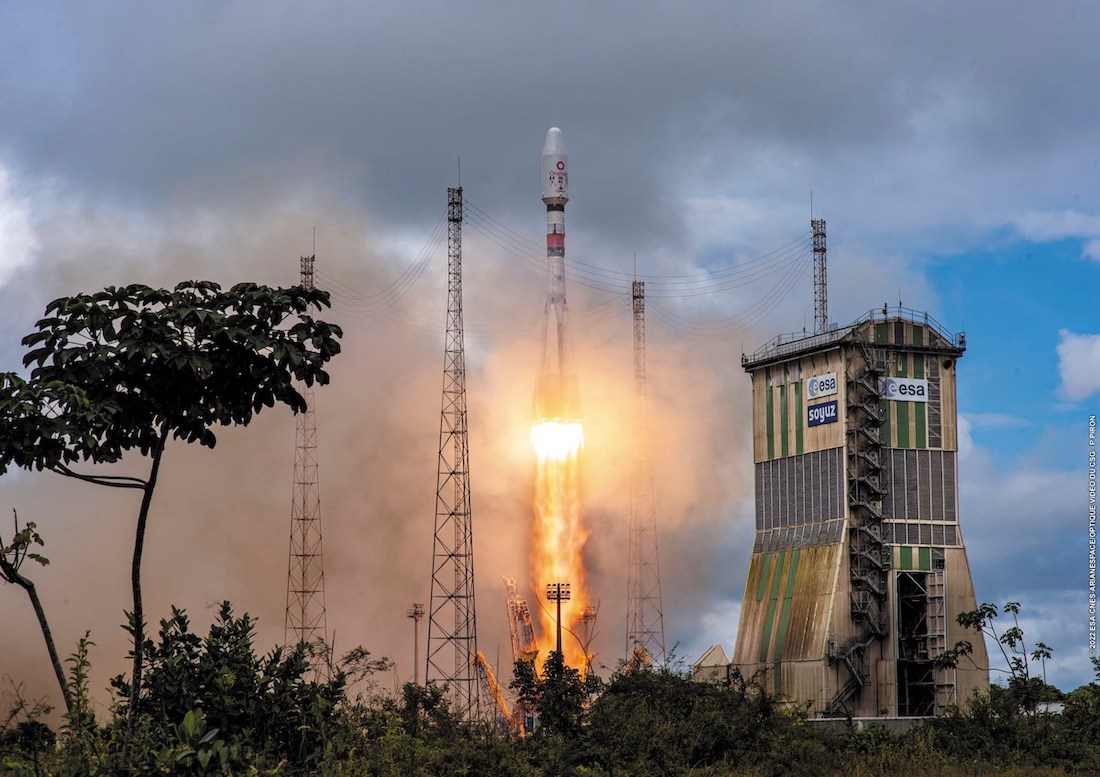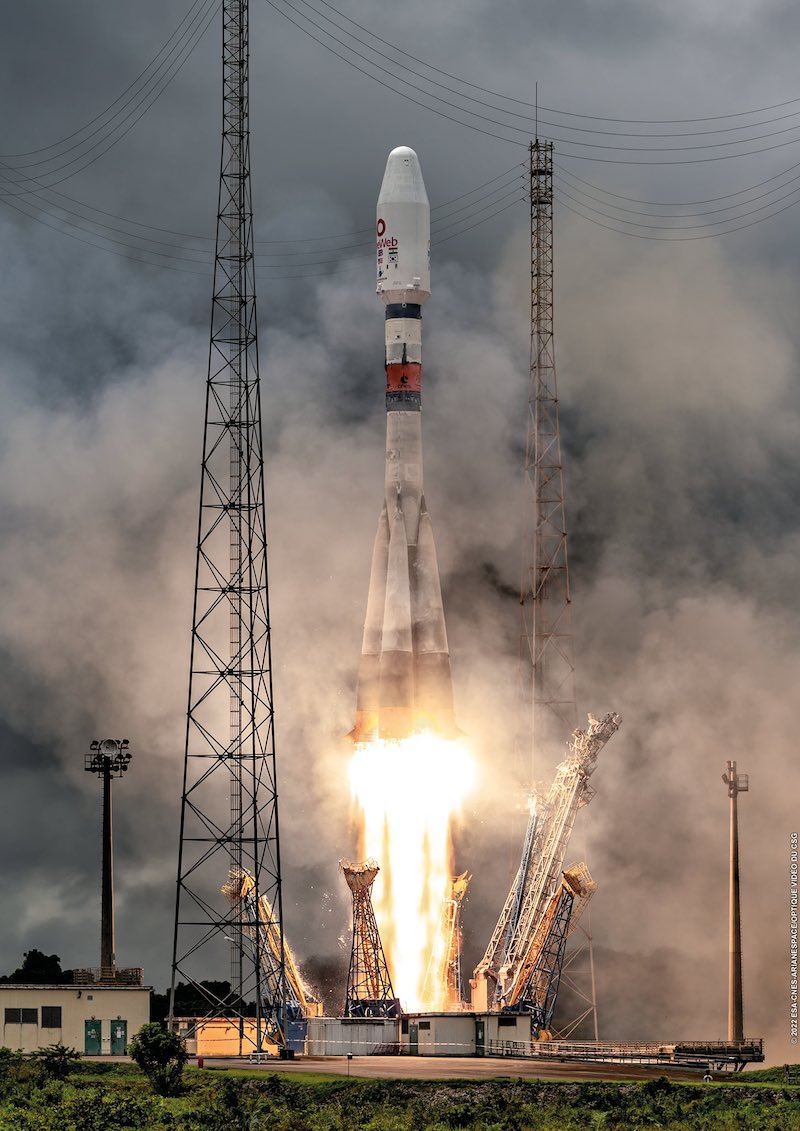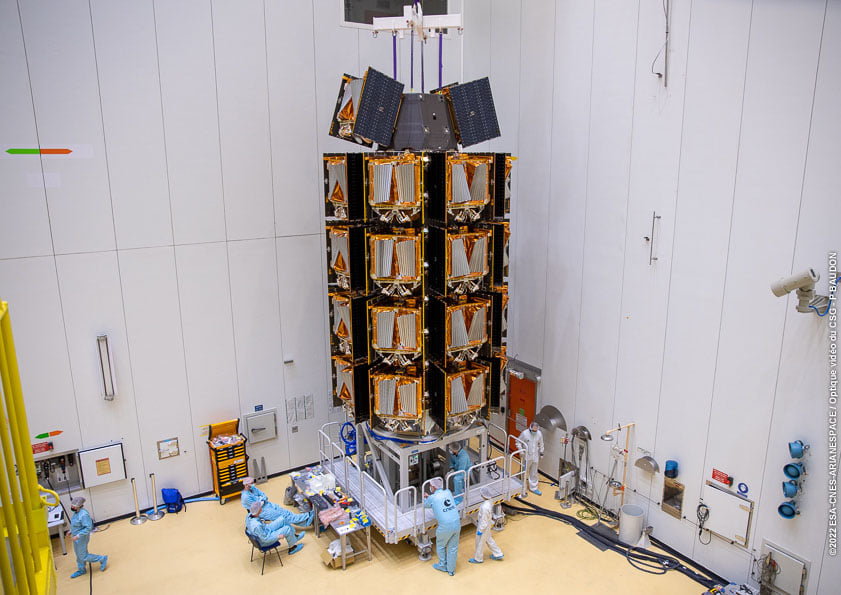
A Russian Soyuz rocket lifted off from French Guiana and hauled 34 new satellites into orbit for OneWeb’s internet network Thursday, bringing the tally of OneWeb spacecraft launched to 428 and marking the company’s fleet two-thirds complete.
OneWeb’s fleet is designed to provide global low-latency, high-speed internet service, placing the London-based company alongside competitors such as SpaceX’s Starlink network, Amazon’s planned Kuiper system, and other small satellite “megaconstellations” in the conceptual or planning phases.
The company plans to deploy 648 spacecraft in its first-generation network, using 19 satellite deployment missions on Russian Soyuz rockets marketed and managed by Arianespace, the French launch service provider. The launch Thursday was the 13th of the 19 planned Soyuz missions for OneWeb.
The kerosene-fueled Soyuz ST-B rocket launched from the Guiana Space Center in South America at 1:09:37 p.m. EST (1809:37 GMT; 3:09:37 p.m. French Guiana time) to begin its climb into a polar orbit.
Speeding north from the South American coastline, the Soyuz rocket dropped its four first stage boosters two minutes into the mission, then shed its clamshell-like payload fairing about three-and-a-half minutes after liftoff.
The core stage finished its job and separated nearly five minutes into the flight, leaving the third stage’s engine to propel a Fregat upper stage onto a suborbital trajectory just shy of the velocity required to reach a stable orbit.

The rocket’s Fregat upper stage fired its main engine twice to inject the OneWeb satellites into an orbit roughly 295 miles (475 kilometers) above Earth.
The first two spacecraft deployed from a dispenser on the upper stage one hour into the mission. The remaining 32 satellites released in groups of four over the next two-and-a-half hours.
Massimiliano Ladovaz, OneWeb’s chief technology officer, said the company’s satellite control team established contact with all 34 spacecraft by Thursday night.
“Our first launch of the year marks our significant progress in completing a truly global LEO network later in 2022,” said Neil Masterson, CEO of OneWeb. “We continue to see growing demand for OneWeb’s industry-leading services as we look forward to delivering on our ambition to build robust, secure, and global access to broadband services.”
The OneWeb satellites, each weighing about 325 pounds (147.5 kilograms at launch), were expected to deploy solar panels and activate xenon ion thrusters to maneuver into their operational orbit at an altitude of 745 miles (1,200 kilometers).
OneWeb’s satellites are built in a factory just outside the gates of NASA’s Kennedy Space Center in Florida by a joint venture between OneWeb and Airbus Defense and Space.

OneWeb’s network is one of two large megaconstellations well advanced into deployment and initial operations. SpaceX’s Starlink internet fleet is the other one.
SpaceX has launched 2,091 satellites for the Starlink network to date using the company’s reusable Falcon 9 rocket fleet. SpaceX’s Starlink satellites fly closer to Earth than OneWeb’s spacecraft — at an altitude of around 340 miles (550 kilometers) — reducing risks that failed satellites will create a long-term space junk problem. But the lower altitude means the Starlink network needs more spacecraft than OneWeb to connect the globe.
Arianespace won a contract in 2015 to launch OneWeb’s first-generation network. After several changes, the deal between Arianespace and OneWeb now covers 19 launches aboard Russian Soyuz rockets from spaceports in Russia, Kazakhstan, and French Guiana.
OneWeb is planning another generation of spacecraft to handle more internet traffic, and that constellation could number thousands of satellites.
The next launch for OneWeb is another Soyuz mission slated for March 4 from the Baikonur Cosmodrome in Kazakhstan.
Last month, Arianespace said it planned up to 17 missions in 2022, including launches from French Guiana, Baikonur, and the Vostochny Cosmodrome in Russia. Arianespace oversees flights using Ariane, Soyuz, and Vega rockets.
Email the author.
Follow Stephen Clark on Twitter: @StephenClark1.
